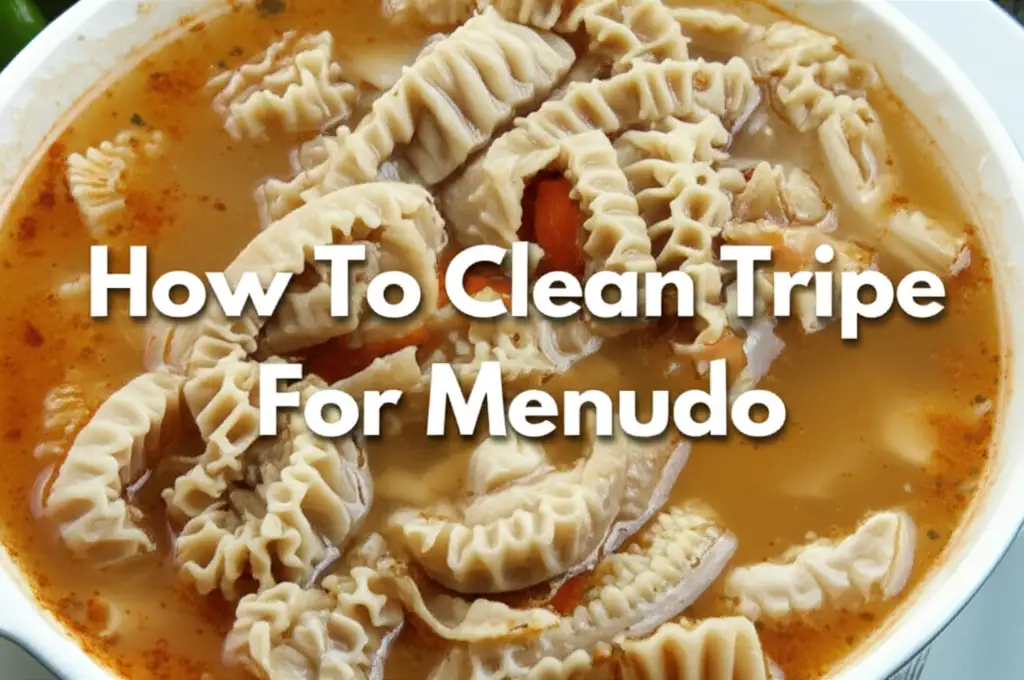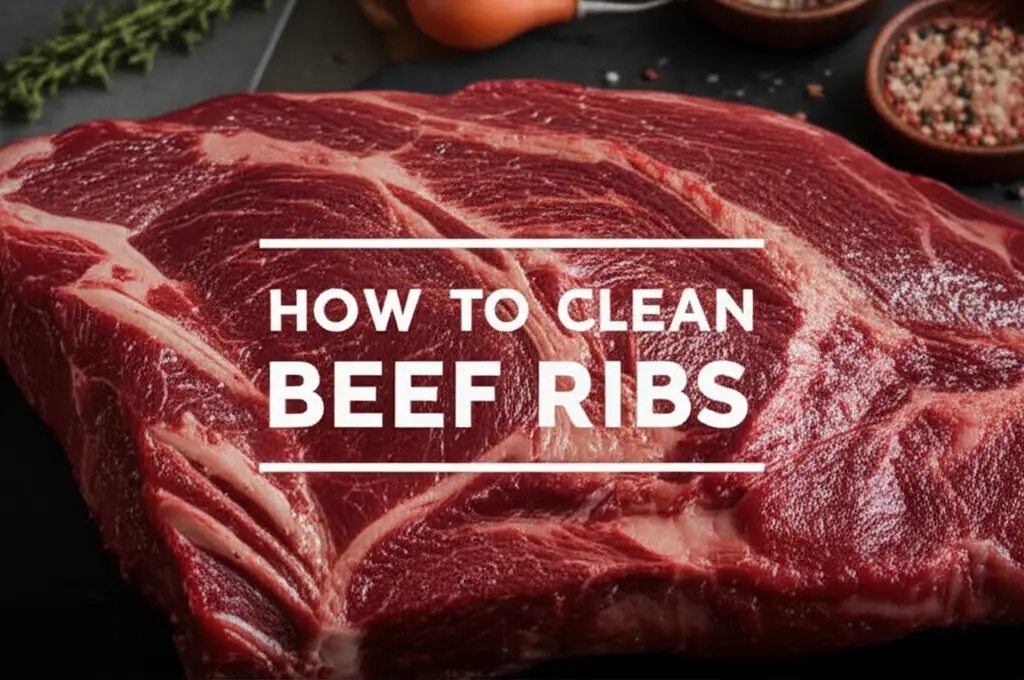· Food Preparation · 16 min read
How To Clean Tripe For Menudo

Mastering Tripe Cleaning for Authentic Menudo
Making menudo is a cherished tradition for many. This rich, flavorful soup starts with one key ingredient: tripe. You know, getting the tripe right makes all the difference. Cleaning tripe properly is the most important step. It removes impurities and strong odors. I learned this process from my family, and it truly changes the final dish.
This article shows you how to clean tripe for menudo. We will cover everything from the initial rinse to the final blanching. We will talk about essential tools and ingredients. You will also learn about scrubbing methods and odor removal. By the end, you will feel confident to prepare tripe like a pro. This guide will help you create a delicious, authentic menudo that everyone will enjoy.
Takeaway
Cleaning tripe for menudo requires a few key steps for the best results:
- Always begin with multiple cold water rinses to remove loose debris.
- Trim away any excess fat and tough membranes.
- Scrub the tripe thoroughly with coarse salt.
- Soak the tripe in a vinegar solution to neutralize odors.
- Blanching in boiling water is essential to further cleanse and tenderize the tripe.
- Perform a final rinse and inspection before cooking.
How do you clean tripe for menudo?
You clean tripe for menudo by rinsing it multiple times under cold water, trimming excess fat, scrubbing it vigorously with coarse salt, and soaking it in a vinegar solution. Blanching the tripe in boiling water for several minutes is a crucial final step to remove lingering impurities and strong odors before cooking.
Understanding Tripe: Types and Why Cleaning Matters
Tripe comes from the stomach lining of various animals, most commonly beef. For menudo, beef tripe is the standard. Different parts of the beef stomach yield different types of tripe. You will find honeycomb, blanket, omasum (also called “libro” because it looks like a book), and reed tripe. Each type has a unique texture and appearance. Honeycomb tripe is very popular due to its tender texture and ability to absorb flavors.
Cleaning tripe is not just about looks; it is about food safety and taste. Raw tripe can have a strong, unappetizing smell. It may contain bits of undigested food or other impurities from the animal’s digestive system. Proper cleaning removes these elements. This step turns a potentially unpleasant ingredient into a delicious one. It also ensures your menudo tastes clean and authentic. I always make sure my tripe is perfectly clean. It ensures a wonderful culinary experience.
Different Cuts of Tripe for Menudo
When you go to the butcher or grocery store, you might see a few kinds of tripe. Knowing the differences helps you pick the best for your menudo.
- Honeycomb Tripe: This is the most common and often preferred type for menudo. It has a distinctive honeycomb pattern. This texture holds the broth well and becomes very tender when cooked. Its unique structure means it requires good rinsing to get into all the crevices. I find this tripe always cooks up beautifully.
- Blanket Tripe (Flat Tripe): This tripe is smooth and flat, without the textured surface of honeycomb. It is thinner and might not offer the same chewiness. Some people mix it with honeycomb for variety. It is still a good option for menudo.
- Omasum Tripe (Book Tripe or Libro): This type has many folds, resembling pages of a book. It has a slightly firmer, chewier texture. It takes a bit more effort to clean between its many layers. I sometimes add a little of this for texture.
- Reed Tripe (Pillar Tripe): This is less common in menudo recipes. It comes from the fourth stomach chamber. It has a more tubular shape. It is generally not as popular for menudo due to its different texture.
Each type offers a slightly different mouthfeel to your menudo. However, the cleaning process remains very similar for all of them. The key is to ensure every surface is clean. This ensures a clean flavor for your soup.
Importance of Cleanliness for Flavor and Safety
The way you clean tripe directly affects your menudo. First, it removes the strong, sometimes off-putting, smell. Uncleaned tripe can make your entire soup taste gamey or unpleasant. This is because of residual digestive fluids and surface impurities. My goal is always to have a fresh, neutral starting point.
Second, cleaning tripe ensures food safety. Tripe is an organ meat. It needs careful handling to remove bacteria and contaminants. A thorough cleaning process reduces the risk of foodborne illness. You want to serve a meal that is both delicious and safe for everyone. This step is non-negotiable for me. It is similar to ensuring your kitchen is spotless, just like how you clean the bottom of a pan after a tough cooking session. You want a clean start for everything related to your food.
Essential Tools and Ingredients for Tripe Cleaning
Cleaning tripe properly means having the right supplies. You do not need fancy equipment. Basic kitchen items work well. These tools help you scrub, rinse, and prepare the tripe effectively. Having everything ready saves time and makes the process smoother.
Basic Kitchen Equipment
Before you start, gather these items:
- Large Bowl or Basin: You will need this for soaking and rinsing the tripe. A big bowl allows plenty of space for the tripe to move freely in water. I usually grab my largest mixing bowl.
- Colander: A sturdy colander helps drain water quickly after rinsing. It is essential for getting rid of all the dirty water between steps.
- Cutting Board: A clean surface for trimming tripe is necessary. Use one dedicated to meat, if possible, to avoid cross-contamination.
- Sharp Knife: You need a good knife to trim away excess fat and tough parts. A chef’s knife or a boning knife works best.
- Stiff-Bristled Brush (Optional but Recommended): While not strictly required, a clean brush can help scrub the tripe. It gets into the honeycomb crevices better than hands alone. Make sure it is food-safe.
These items are simple but vital. They make the cleaning process much easier. A well-equipped kitchen helps you tackle any food prep challenge.
Cleaning Agents: Salt, Vinegar, and Lime (Cal)
These ingredients are your best friends when cleaning tripe. They help remove impurities and neutralize strong odors.
- Coarse Salt: This is your primary scrubbing agent. Coarse salt, like kosher salt, provides the abrasion needed to rub off slime and surface impurities. Its颗粒 help loosen anything clinging to the tripe. I use a generous amount of salt for a thorough scrub.
- White Vinegar: Vinegar is an acid. It is excellent for neutralizing strong odors. Soaking tripe in a vinegar solution breaks down compounds that cause the gamey smell. It leaves the tripe with a much cleaner scent. You can also use vinegar for many other tough cleaning jobs, such as how to clean mold with vinegar. This shows its powerful cleaning properties.
- Pickling Lime (Cal, Calcium Hydroxide) (Optional): Some traditional recipes use pickling lime. It helps whiten the tripe and can give it a slightly firmer texture. This is an optional step, and many people skip it. If you use it, be sure to buy food-grade pickling lime and follow instructions carefully. It needs very thorough rinsing afterwards. I personally do not always use it, but it is an option for certain results.
Using these agents in the right way ensures your tripe is clean and ready for cooking. They are effective and safe for food preparation.
Step-by-Step Guide: Initial Rinse and Trim
The first steps in cleaning tripe are about removing the most obvious impurities. This initial process prepares the tripe for deeper cleaning. Do not rush these steps; they lay the foundation for a truly clean ingredient.
First Rinse Under Cold Water
When you first get your tripe, it might look a little unappetizing. It often has a yellowish tint and some loose bits. Your very first action is to give it a good, thorough rinse under cold running water.
- Place the tripe in your large bowl or basin.
- Fill the bowl with cold water. Make sure the tripe is completely submerged.
- Agitate the tripe with your hands. Swish it around to loosen any dirt or debris. You will see the water become cloudy.
- Drain the dirty water immediately.
- Repeat this rinsing process at least 3-4 times. Keep rinsing until the water runs mostly clear. I always do this several times until I feel the loose stuff is gone. This simple step removes surface grime and some of the initial unpleasant smell.
This first rinse is essential. It prevents you from spreading dirt during the next steps. It is like sweeping before you mop; it prepares the area for a deeper clean.
Trimming Excess Fat and Membranes
After the initial rinses, you will notice parts of the tripe that need to be removed. These are usually excess fat, stringy membranes, or tough, darker sections. Trimming these away improves both the texture and the flavor of your menudo.
- Lay the rinsed tripe flat on your cutting board.
- Examine the tripe carefully. Look for any visible yellow fat deposits. Also, look for any tough, translucent membranes that might be clinging to the surface.
- Using your sharp knife, carefully trim away the excess fat. Tripe contains a lot of flavor, but too much fat can make your menudo greasy. Cut close to the tripe, but avoid cutting into the good meat.
- Peel off any tough membranes. These can be difficult to chew if left on. Sometimes, they peel off easily. Other times, you might need your knife to get under them.
- Remove any discolored or very tough parts. Some pieces might have a very dark or unusual color. These usually indicate areas that will remain tough or impart a bad flavor. Cut these off. I am always quite ruthless with this step. If it looks bad, it goes.
This trimming step is important. It ensures that only the best parts of the tripe make it into your menudo. It also makes the scrubbing process more effective, as you are working with cleaner surfaces.
The Scrubbing and Soaking Process
Now that the tripe is rinsed and trimmed, it is time for the more intensive cleaning. This involves scrubbing with salt and soaking in vinegar. These steps are crucial for neutralizing odors and thoroughly cleansing the tripe’s surface.
Using Salt for Scrubbing
Scrubbing with coarse salt is a traditional and very effective method. The salt acts as an abrasive, helping to scrape off any remaining slime or impurities from the tripe’s surface.
- Place the tripe back into your clean large bowl. Make sure it is slightly damp, but not submerged in water.
- Sprinkle a generous amount of coarse salt over the tripe. I usually use about 1/4 to 1/2 cup for a standard amount of tripe (around 2-3 pounds). You want enough salt to coat all surfaces.
- Rub the salt vigorously into every part of the tripe. Use your hands to massage and scrub. Pay special attention to the honeycomb folds if you are using that type. Dig your fingers into the crevices. The salt will help loosen and lift away any remaining film or odor-causing elements. This scrubbing might take 5-10 minutes. You will feel the texture change under your hands, becoming less slimy.
- After scrubbing, let the tripe sit with the salt for 5-10 minutes. This allows the salt to continue drawing out impurities.
- Rinse the tripe thoroughly under cold running water. Make sure all the salt and any loosened debris are washed away. Rinse until the water runs completely clear again. I often rinse it 3-4 more times, squeezing the tripe gently. This ensures no salt residue remains.
This salt scrub is a game-changer. It is like a deep clean for your tripe, making it much more appealing.
Vinegar Soaks for Odor Removal
Even after the salt scrub, tripe can still have a faint smell. A vinegar soak is excellent for neutralizing these remaining odors. Vinegar’s acidity breaks down the compounds that cause unpleasant smells.
- After rinsing off the salt, place the tripe back into the clean bowl.
- Pour white vinegar over the tripe. Use enough to cover it completely or dilute it with an equal amount of water. For 2-3 pounds of tripe, I typically use 1-2 cups of undiluted vinegar.
- Let the tripe soak in the vinegar solution. Leave it for at least 30 minutes, but up to 1 hour. Some people even soak it overnight in the refrigerator. I usually aim for an hour to be sure.
- After soaking, drain the vinegar solution. Do not rinse the tripe just yet. You want to move directly to the blanching step. The vinegar smell will be strong now, but it will dissipate.
This vinegar step is powerful for odor removal. It prepares the tripe for the final purification stage. It makes a big difference in the final taste of your menudo. This kind of deep cleaning, using acidic solutions, is very effective for breaking down tough substances. You see similar principles used when tackling stubborn grime, like cleaning a shower with vinegar. The acid helps cut through and eliminate unwanted residues.
Blanching Tripe: A Crucial Step for Purity
Blanching is the final and perhaps most critical step in cleaning tripe for menudo. This process involves a quick boil. It achieves several important things. It further purifies the tripe, removes any lingering odors, and helps tenderize it slightly. Skipping this step can result in a gamey-tasting menudo.
The Purpose of Blanching
You might wonder why boiling the tripe is so important after all the scrubbing and soaking. Blanching serves several purposes:
- Odor Elimination: High heat helps to release and evaporate any remaining volatile compounds that cause strong smells. Even if you soaked it in vinegar, blanching provides an extra layer of odor neutralization. This is the ultimate step to ensure a clean aroma.
- Impurity Removal: The boiling water pulls out more impurities that might still cling to the tripe. You will often see scum or foam rise to the surface of the water during blanching. This is exactly what you want to get rid of.
- Initial Tenderization: While tripe needs a long cooking time in the menudo, blanching gives it a head start. It begins to break down some of the tougher fibers. This makes the tripe softer and more pleasant to eat later.
- Texture Improvement: Blanching can slightly firm up the tripe, improving its overall texture before the long simmer. It prepares the tripe for the final cooking.
I always consider blanching non-negotiable. It truly sets the stage for perfect menudo.
Blanching Method
The blanching process is straightforward but needs attention. You want to boil the tripe enough to cleanse it, but not cook it completely.
- Fill a large stockpot with water. Use enough water to fully submerge all the tripe. Do not add anything to this water, just plain water.
- Bring the water to a rolling boil over high heat. Ensure the water is bubbling vigorously.
- Carefully add the drained, vinegar-soaked tripe to the boiling water. Be careful, as the water might foam up slightly.
- Let the tripe boil vigorously for 5-10 minutes. I usually go for 7-8 minutes. During this time, you will likely see a grayish foam rise to the surface. This foam is the impurities being released. This is normal and expected.
- After 5-10 minutes, carefully remove the tripe from the boiling water. Use tongs or a slotted spoon.
- Immediately transfer the blanched tripe to a colander. Place the colander in a sink.
- Discard the boiling water in the pot. Do not reuse this water for your menudo. It contains all the impurities you just removed.
This blanched tripe is now ready for the final rinse. It will look noticeably cleaner and have a much milder smell. This is the tripe you want for your menudo.
The Final Rinse and Inspection
You are almost done! After blanching, the tripe is very close to being ready. The final rinse ensures all impurities from the blanching process are gone. A careful inspection gives you confidence in your hard work.
Rinsing After Blanching
Even though you discarded the dirty blanching water, the tripe itself will still have some residue. A thorough cold water rinse is essential.
- With the tripe still in the colander, place it under cold running water.
- Rinse the tripe thoroughly for several minutes. Use your hands to rub and agitate the tripe. Ensure water flows over and through all surfaces, especially the honeycomb folds.
- Rinse until the tripe feels completely clean and the water runs perfectly clear. There should be no signs of foam or cloudiness. I usually rinse for a good 5 minutes.
- Let the tripe drain well in the colander. Press down gently to help excess water escape.
This final rinse makes sure your tripe is truly pristine. It removes any lingering bits of scum or residual smell from the blanching process.
Visual Check for Readiness
Once rinsed, give your tripe a final, thorough visual inspection. This is your last chance to ensure it is perfect before cooking.
- Spread the tripe out on your clean cutting board.
- Examine every piece. Look for any dark spots you might have missed. Check for any remaining tough membranes or bits of fat. If you find any, trim them off now with your knife.
- Smell the tripe. It should have a very mild, almost neutral odor. There should be no strong, gamey, or unpleasant smells. A clean smell confirms your work was successful.
- Feel the tripe. It should feel clean to the touch, not slimy or greasy. The texture should be slightly firm but pliable.
If your tripe passes this final inspection, congratulations! It is now clean and ready to be cut into pieces for your menudo. You can proceed with confidence, knowing you prepared the foundation for a truly delicious soup. My favorite part is knowing that the hard work is done. Now, the enjoyable cooking can begin.
Advanced Tripe Cleaning Tips and Troubleshooting
Even with a standard method, some situations might require extra steps or different approaches. Here are some advanced tips and ways to troubleshoot common issues when cleaning tripe. These ideas help you achieve the cleanest tripe possible.
Using Pickling Lime (Cal) for Extra Whiteness (Optional)
As mentioned before, pickling lime (food-grade calcium hydroxide, often called “cal” in Mexican cuisine) is an optional but traditional ingredient some people use. It helps whiten the tripe and can give it a slightly firmer, chewier texture. If you want that very specific bright white look, this step is for you.
- Prepare the lime solution: In a large non-reactive bowl, mix about 1-2 tablespoons of food-grade pickling lime with several cups of water. Stir until the lime dissolves. The solution will look milky.
- Soak the tripe: After your initial rinses and trimming, submerge the tripe in the lime solution.
- Soak time: Let it soak for 15-30 minutes. Do not soak for too long, as it can make the tripe too tough.
- Rinse thoroughly: This is the most crucial part. After soaking, rinse the tripe extremely well under cold running water. Rinse for at least 10-15 minutes, constantly agitating and squeezing the tripe. You must remove all traces of the lime. Any remaining lime will give the tripe a chalky taste and can affect the flavor of your menudo.
- Continue with salt scrub and vinegar soak: After the lime rinse, proceed with the salt scrubbing and vinegar soaking steps as described earlier. The lime is an additional step, not a replacement.
I sometimes use lime when I want that extra-bright tripe, but always remember the extensive rinsing needed.
- tripe cleaning
- menudo recipe
- beef tripe
- preparing offal
- Mexican cooking




